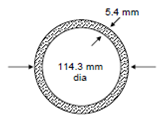Tubular (Pipe) Columns:
Steel or cast iron tubes and pipes have a larger radius of gyration (r = 0.35 dm where dm is the mean diameter of the pipe) than solid steel rods of the same cross sectional area. Hence, the slenderness ratio is lowered and the corresponding permissible stress in compression is increased. Standard steel tubes of various nominal bores are available. They are normally available in three classes: light, medium and heavy.
Example
Find the load carrying capacity of a steel tubular column of 3 m length. One end of the pipe is fixed and the other end is pinned to the supports. The nominal bore of the heavy class pipe is 100 mm.

Figure
Solution
Properties of the 100 bore heavy pipe:
Outside diameter = 114.3 mm; thickness = 5.4 mm
Area of cross section = 18.5 cm2, radius of gyration = 3.85 cm = 38.5 mm.
The effective length of the column from Table 1 case (b) is
0.80 × 3 = 2.4 m = 2400 mm.
∴ Slenderness ratio, λ = 2400/38.5 = 62.3
The corresponding value of σac (for fy = 250) is 119.7 MPa.
∴ Load carrying capacity = σac .A = 119.7 × 1850 N = 221.4 kN.